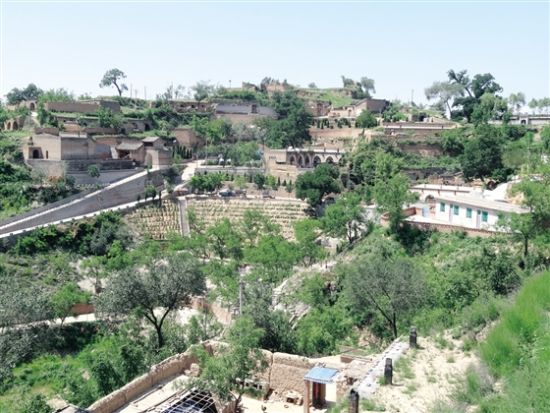|
|
|
Overview of the village [Photo/pingyao.gov.cn] |
The village of Liuhe, in the southeastern part of Pingyao county, Shanxi province, is a new tourism spot and World Cultural Heritage site that has interesting vegetation and animals, landscape, folk culture, religion, and a merchant culture that flourished back in the Ming (1368-1644) and Qing (1636-1912) dynasties, as well as historic sites from World War II. It sits adjacent to Baota Mountain, with loess hills and brooks, and is dotted with old trees and terraced fields. Visitors here can experience a unique, natural culture and history.
The village is about 20 kilometers from the center of Pingyao county and can be reached in 35 minutes by car. In the visitor gallery, you can see a great variety of pine, willow, poplar, Chinese scholar trees, vegetation, and fields smelling of grains and fruit that attract birds and animals, such as woodpeckers, condors, rabbits, boar, and squirrels.
 |
| Overview of the village [Photo/pingyao.gov.cn] |
Before the 1980s, the village was extremely poor and barren and was closed to the outside, but then the village council changed and began 20 years of improvements, with Guo Qingsheng, the council head, explaining that they tackled two major problems -- transportation and water. The village now has miles of roads and paths that make it accessible in many ways. It also has parking lots. The water problem was addressed with a 240,000-yuan ($40,000) fund for infrastructure, an irrigation system, and two reservoirs.
|
|
| Landscape above Liuhe, Pingyao county, Shanxi [Photo/pingyao.gov.cn] |
Now, it sees business opportunities in the large number of tourists who travel to Pingyao county and is looking at rural tourism. Guo started a program to return grain plots to forests and greening elsewhere, while considering the local climate, hence the plots of walnut, apple, and other fruit trees, and peppers, with green coverage now amounting to 85 percent of the village. Farming and animal husbandry have also advanced so that the local eggs and millet are famous, with their own brands, and are considered wonderful holiday gifts. More tourists now come to the village to enjoy themselves in the farming, fruit picking, and cottage areas and they can also have the unique experience of staying in a cave-house.
The relics are well preserved and even some traditional agricultural tools have been passed down from generation to generation. Each year, there are folk activities and festivals still held in the village, as a great way to entertain visitors, for example, the candle fair and ritual of prayers for rain.
Another popular tourist spot in the typical Ming dynasty residence of Zhang Jiangsheng, a landlord and merchant, with an exquisitely decorated house and many wood carvings, pieces of furniture, paintings and sculptures from that time. The tasteful relics show how well-off and successful the Zhang Family were as merchants. Another worthwhile building is the dramatic stage where the wall paintings of tales and records of actors still tell a story after hundreds of years. A close look at the village will show you how strong religion, culture and entertainment were in the village. But, there are more stories beyond the culture and religion, because it was here where the Pingyao county council met during the War of Resistance against Japanese Aggression (1937-1945), leaving some war-time sites that now serve as “red tourism” resources. In 1943, when the war was at its peak, the county council, under the leadership of the Chinese Communist Party was transferred here, and many of the council offices are still as they were originally. The war-time folk museum is becoming a center of patriotic activities.
Edited by Roger Bradshaw